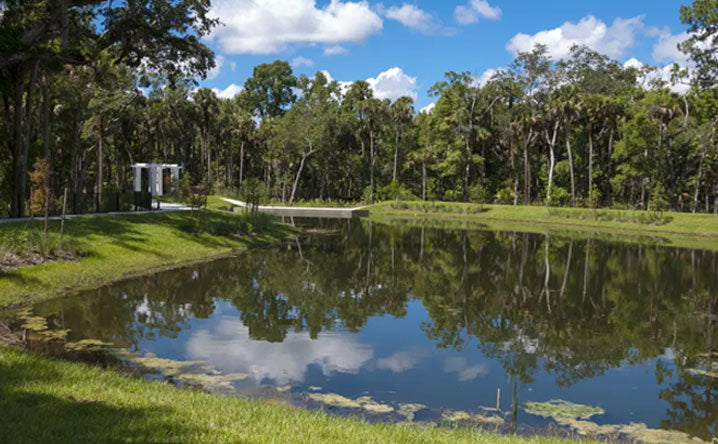Introduction
Understanding the distinction between retention and detention ponds is crucial in environmental management and urban planning. These water management systems control runoff, prevent flooding and support biodiversity. Detention ponds, designed for temporary water storage, rapidly drain to maintain capacity for the next rainfall. However, retention ponds are permanent bodies of water aiming to improve water quality and provide aesthetic value. This article explains their differences, purposes, and functionalities, shedding light on how they contribute to sustainable development and environmental conservation.
Exploring Detention Ponds
Detention ponds are engineered solutions crucial for managing stormwater in urban environments. These temporary storage facilities capture excess runoff from heavy rains and melting snow, reducing the risk of flooding and erosion downstream. By temporarily holding water, detention ponds allow sediments to settle before gradually releasing the water back into the environment, often through a controlled outlet. This process mitigates immediate water surges but also aids in maintaining the natural hydrological balance in developed areas. Dry detention ponds are an essential component of modern stormwater management systems, serving as a buffer to protect communities and natural waterways from the impacts of urbanization.
Understanding Retention Ponds
Retention ponds are crucial in managing stormwater, particularly in urban settings where surface runoff can't easily infiltrate the ground. Unlike their counterparts, retention ponds can hold water indefinitely, allowing for natural percolation and evaporation into the soil. This permanent pool serves multiple purposes: it reduces the risk of flooding, improves water quality by settling sediments, and supports local ecosystems. Moreover, retention ponds are often incorporated into the landscape to provide communities with aesthetic value and recreational spaces. When properly maintained, they become a sustainable component of urban planning, contributing to the overall well-being of the environment and its inhabitants. Understanding the functionality and benefits of a retention basin is essential for those looking to implement effective water management solutions in both new and existing developments.
Key Differences Unveiled
Design Philosophy and Purpose
Detention and retention pond services serve unique roles in urban water management. Dry detention basins temporarily hold stormwater, mitigating flood risks by controlling the discharge rate to watercourses. Their primary purpose is to protect infrastructure and communities from flooding during heavy rainfall. In contrast, retention ponds can hold a certain amount of water permanently, acting as a basin to capture runoff while providing environmental benefits like supporting local wildlife habitats and improving water quality through natural filtration processes.
Mechanisms of Water Management=
Water management strategies between the two pond types vary significantly. A detention basin focuses on volume control, temporarily storing stormwater and slowly releasing it to prevent overwhelming storm sewer systems. These ponds often feature outlet structures that regulate the flow rate. Retention ponds, however, aim to maintain a consistent water level, utilizing evaporation, and percolation to manage water levels. Retention ponds can sometimes require the use of pond care supplies to be maintained properly. They are essential in recharging groundwater and reducing pollutants.
Regulatory and Space Requirements
Regulations for constructing and maintaining detention and retention ponds differ based on local environmental policies and land use planning objectives. Detention ponds typically require robust engineering to ensure effective stormwater management, often necessitating more complex approval processes. Retention ponds, while also subject to regulations, are additionally focused on long-term ecological balance, requiring considerations for aquatic life support and water quality maintenance. Space requirements vary, with retention ponds needing more area to facilitate their permanent water feature.
Challenges and Limitations
Detention ponds face challenges like sediment accumulation and the potential for increased mosquito breeding sites if not properly maintained. They may also dry between rain events, reducing their aesthetic and recreational value. Retention ponds, while offering more consistent ecological benefits, require ongoing management to prevent algae blooms and maintain water quality. Both types demand careful planning to balance urban development with environmental sustainability.
Overview of Construction and Maintenance Costs
The costs associated with constructing and maintaining these ponds vary widely. Detention ponds, emphasizing flood control, often involve significant upfront construction costs due to the need for engineered control structures. Retention ponds might have lower initial construction costs but can incur higher long-term maintenance costs, especially if they are part of an ecological habitat or recreational area. Both require a commitment to regular upkeep to ensure they function as intended and comply with local regulations.
Synergistic Potential: Combining Detention and Retention Ponds
Integrating detention and retention ponds within a landscape offers a multifaceted water management and environmental conservation approach. By harnessing the strengths of both systems, communities can achieve enhanced flood control while promoting water quality and biodiversity. Detention ponds can effectively manage stormwater surges, protecting infrastructure and reducing the risk of flooding. Paired with retention ponds, which support ecological balance by maintaining permanent bodies of water, the combined system facilitates a continuous cycle of water purification and habitat support, maximizing use and aligning with sustainable development goals, offering a blueprint for future urban planning. The collaboration between these pond types exemplifies how thoughtful design can address complex environmental challenges, creating resilient and thriving ecosystems within urban environments.
Conclusion
The distinction between detention and retention ponds is more than terminological—it's functional, each serving a unique purpose in water management. Detention ponds are invaluable for controlling runoff and mitigating flood risks, whereas retention ponds play a crucial role in water quality improvement and providing habitat. Understanding these differences is critical to implementing effective water management strategies. By integrating both types of ponds, communities can enhance their resilience to weather extremes and contribute to environmental sustainability. This guide aims to empower you with the knowledge to make informed decisions for your water management needs, ensuring both safety and environmental stewardship.

